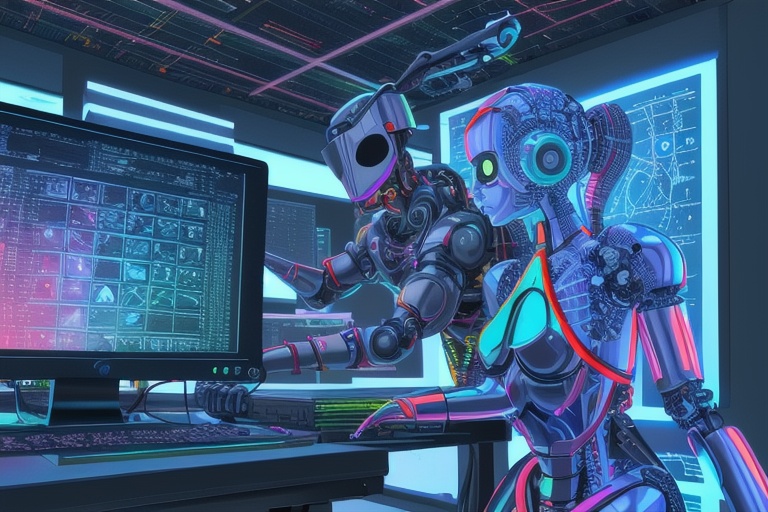Artificial Intelligence (AI) has swiftly transitioned from a novel concept to a ubiquitous reality, permeating through various facets of our daily lives. Its influence spans multiple sectors, from the convenience of smartphones to the intriguing prospects of self-driving cars. This technological marvel holds the potential to transform the world we know—streamlining processes, enhancing capabilities, and even redefining industries. It is the beacon of today's digital disruption, and its trajectory sets the stage for a future brimming with possibilities.
Artificial Intelligence (AI) has swiftly transitioned from a novel concept to a ubiquitous reality, permeating through various facets of our daily lives. Its influence spans multiple sectors, from the convenience of smartphones to the intriguing prospects of self-driving cars. This technological marvel holds the potential to transform the world we know—streamlining processes, enhancing capabilities, and even redefining industries. It is the beacon of today's digital disruption, and its trajectory sets the stage for a future brimming with possibilities.
Understanding AI: A Primer
Before we venture into the myriad impacts of AI, it is imperative to grasp its essence. At its most basic level, AI signifies the replication of human intellect through machines, designed to mirror our cognitive functions. This capability to independently think and learn is what sets it apart from traditional computing paradigms. AI is commonly categorized into three distinct types based on their sophistication: weak AI, strong AI, and super AI. Weak AI excels in performing specific tasks within a defined scope, whereas strong AI aspires to imitate the full spectrum of human intelligence. Finally, super AI, a concept yet to be realized, represents a form of intelligence that would surpass human capabilities.
The Canvas of AI Advantages
The advent of AI technology has unlocked an array of benefits that were once beyond reach. In the healthcare landscape, AI's precision and efficiency have transformed patient care—sharpening diagnostic tools, crafting customized treatment plans, and ultimately elevating patient outcomes to unprecedented highs. In fields like marketing, AI's data-driven insights have refined targeting strategies, leading to more engaging campaigns that drive better conversion rates and increased returns on investment.
Education too has witnessed a paradigm shift, as AI-enabled systems offer personalized learning paths, enabling students to absorb knowledge at their own pace, and interact with content that resonates with their learning preferences. Moreover, creative industries have started to explore AI's potential to boost human creativity, catalyzing innovation and inspiring new forms of artistic expression.
Transportation stands on the cusp of a revolution as AI promises to deliver safer, more efficient, and seamlessly managed traffic systems—a future where road mishaps could dwindle and commute times reduce significantly.
Navigating AI's Challenges
Despite the bright outlook, the journey with AI is not without its challenges. As we integrate AI into the workplace, there is a palpable fear of job displacement, stirring debates about the future of employment. Addressing these concerns requires thoughtful strategies that can reskill workforces and shift the focus to job creation in emerging sectors influenced by AI.
Moreover, AI raises profound ethical questions that strike at the core of our societal values. Issues surrounding privacy, autonomy, and decision-making call for a meticulous approach in integrating technology with due respect for human dignity and rights. The path forward demands a synergy between AI and human oversight, ensuring that this powerful tool enhances our capabilities rather than obfuscating the human element.
Balancing Act: AI and Human Collaboration
To fully harness the potential of AI, we must tread a path of balance—one that respects the technology's power while anchoring it to human values and opportunities. The call to action is clear: By capitalizing on AI's strengths and addressing its weaknesses, we can pave the way for a responsible and advantageous amalgamation of AI across sectors.
The future beckons with a promise—as we stand on the precipice of change, it is both our challenge and our opportunity to shape AI into a force that not only empowers but also preserves what it means to be human. By intertwining AI's capabilities with human insight, creativity, and empathy, we can forge a world where technology serves society, elevating our collective experience and driving us toward shared prosperity.
AI, in its many forms, is more than a mere technological advancement—it is a transformative power that echoes through our lives, reshaping the world with every innovation. Its influence is a testament to human ingenuity and a harbinger of a future where the symbiosis between man and machine fosters progress and harmony. AI's narrative is still being written, and with thoughtful stewardship, it can be a story that uplifts, liberates, and illuminates the best of what our technological age has to offer.
Information for this article was gathered from the following source.

